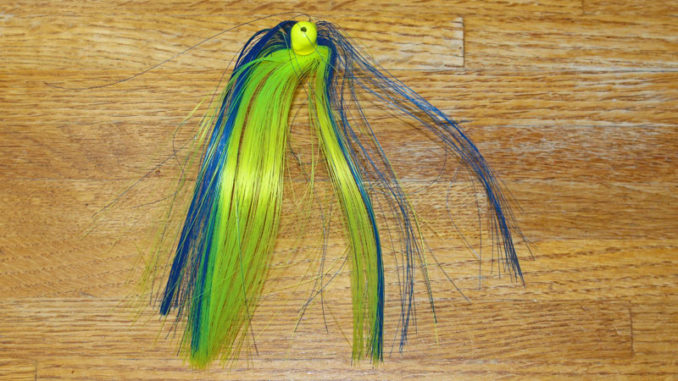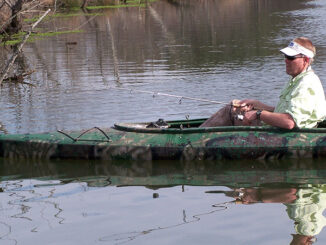
Fish just taste better when you catch them yourself. While this statement is virtually impossible to quantify, if you’re reading this column, you most likely already accept it as gospel.
Let’s take it a step further. Fish taste better when you catch them yourself, on tackle that you made yourself. If you haven’t had a chance to test that theory, don’t stress. It’s not that hard!
In the offshore game, it’s hard to beat a Sea Witch style head in front of a ballyhoo. Sea Witches have been around for generations, and they are extremely simple contraptions. It’s just a painted lead head, tiny eyes, and a groove to whip hair into. Eventually they wear out, and you have a lead head with no hair.
At one point I had a few dozen of these “retired” heads. Once I figured out how to bring them back to life, I never bought another head. I just started making crazy ones, patterns that you couldn’t buy in a store or imagine in real life.
Not only did this save me a good bit of disposable income over the long run, but it was also just a bit more gratifying when one I tied was the first one in the spread to get bit. I can’t say that it happened every time I put baits in the water, but it was at least more than once.
The method
After much trial and error, the recipe that I finally landed on to secure new hair to old heads was 15-pound SpiderWire Invisi-Braid and clear epoxy. I used a fly-tying vise to hold the head in place, cleaned out any residue left in the groove, cut 2 feet or so of the Invisi-Braid, and secured it to the base of the groove with a clove hitch, then put two half-hitches in each “leg” of the braid. Then it was time to pick out the colors I wanted on that particular head.
Both Jodie Gay at Blue Water Candy and Joe Shute were very helpful in finding and selling me the colors I wanted, especially that “crystal” white that seems to glow in the water.
I’d arrange my hair around the groove, with about 75 percent of it facing forward, past the front of the head. Using one of the ”legs” of the braid, I’d make a couple of wraps, cinching it down but not completely tight. Then it was time to arrange my hair so that it was evenly distributed around the groove.
When I had it where I wanted it, with the colors in the right places, then I would really cinch down, flaring the hair out and pulling the braid as tight as possible with the base of the groove. I would wrap as much as I could with the “leg” I had already started with. When I got near the end of the braid, I’d tie a stopper knot (four or five turns) and pull it as tight as I could. Then it was a simple matter of taking the other “leg” and wrapping the other way, over the first “leg.”
I’d finish the tying process with a series of half-hitches on the remaining braid, trim both tag ends with a razor blade, and coat the braid all the way around with a coat of epoxy.
Finishing touches
When the epoxy was completely dry and hard, it was time to pull out any excess hair that didn’t really get sealed to the groove, and to trim each side.
What I found after a lot of experimentation was that I wanted to keep the hair on Sea Witches fairly short on the trailing side of the head.
Usually, I would cut the hair on that side (which becomes the interior skirt when the water pressure pulls the leading hair back and over the bait) to about a quarter of an inch from the head itself. Also, I found that these contraptions work better when the hair is sparse, rather than thick. It doesn’t take much hair to dress up your bait much, and too much hair can often turn things into a tangled mess. A lighter load of hair is also much easier to secure to the groove for a longer lasting result.
Don’t think that this practice of tackle making/resurrection is just for Sea Witches, either. If you have older, Ilander-style heads, you can do the same thing. Just take a razor blade and cut out the original hair and wraps and you have a blank canvas to work with. Any color combination you desire is now attainable, at a fraction of the price of buying new.
If you really want to get crazy, find the size of rubber “Octopus-style” skirt that will fit snugly on your old head, cut the top off, and slide it down over the groove. Then add your hair the same way.
You can take this concept as far as you want to go. One of my first quasi-charter boat jobs was on an old Mako out of Georgetown, SC, working for perhaps the crustiest old captain on the East Coast.
While this guy could be a bit rough around the edges, he did have a flair for creativity. We had on board a bunch of popper heads (similar to an Iland Sailure, only smaller) that you couldn’t find anywhere else. I eventually figured out that this guy had taken all of the tops of his wife’s lipstick containers, drilled the tops, painted them all with chrome spray paint, and skirted them. When the tops on them were drilled dead center in the top, they caught dolphin and tuna like crazy. They weren’t the longest lasting lure heads, and his wife pitched more than a minor fit when she realized that all of her lipsticks had dried out, but they did their job.
I can see the C.E.O. of C&H Lures having a problem with this concept and this month’s column. I’m okay with that. Those guys sell a ton of tackle when it’s all said and done, and they probably always will.
Not everyone has the time or the patience to experiment with resurrecting or creating their own tackle, and those that do will take it to a different level. I never got to a point where I learned how to cast and finish resin heads for marlin lures, but I’d sure like to. I can just tell you it’s inherently more fun and rewarding when the fish you hook jumps with your own home cookin’ hanging out of its mouth!
Money saver:
Creating your own lures, whether out of old, worn-out parts or from your wife’s lipstick tubes, you can save a lot of money over purchasing new lures. But that’s not the best part of it. Catching a fish on a lure you made is one of the most rewarding feelings an angler can experience.




Be the first to comment